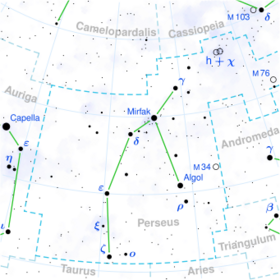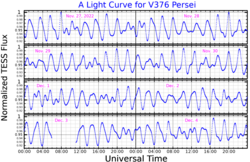Astronomy:HR 1170
| Observation data Equinox J2000.0]] (ICRS) | |
|---|---|
| Constellation | Perseus |
| Right ascension | 03h 49m 08.10977s[1] |
| Declination | +43° 57′ 47.3016″[1] |
| Apparent magnitude (V) | 5.77 - 5.91[2] |
| Characteristics | |
| Spectral type | A9IV[3] |
| U−B color index | 0.06[4] |
| B−V color index | 0.26[4] |
| Variable type | Delta Scuti[2] |
| Astrometry | |
| Radial velocity (Rv) | −11.1±2.6[5] km/s |
| Proper motion (μ) | RA: −3.453±0.244[1] mas/yr Dec.: 11.469±0.200[1] mas/yr |
| Parallax (π) | 14.6959 ± 0.2134[1] mas |
| Distance | 222 ± 3 ly (68.0 ± 1.0 pc) |
| Absolute magnitude (MV) | 1.73±0.07[6] |
| Details | |
| Mass | 1.98±0.04[7] M☉ |
| Radius | 2.7[1] R☉ |
| Luminosity | 23±2[7] L☉ |
| Surface gravity (log g) | 3.77[1] cgs |
| Temperature | 7194±50[8] K |
| Metallicity [Fe/H] | 0.30[3] dex |
| Rotational velocity (v sin i) | 103[7] km/s |
| Age | 1.12[1] Gyr |
| Other designations | |
| Database references | |
| SIMBAD | data |
HR 1170, also known as HD 23728 and V376 Persei, is a star about 220 light years from the Earth, in the constellation Perseus.[1] It is a 5th magnitude star, so it will be faintly visible to the naked eye of an observer far from city lights. It is a variable star, whose brightness varies slightly from magnitude 5.77 to 5.91.[2]
Michel Breger announced that HR 1170 is a Delta Scuti variable star in 1969, based on observations taken over 6 hours and 10 minutes on October 13, 1967. He reported that it varied with a mean amplitude of 0.08 magnitudes, over a period of 2.2 hours.[11] In 1970 it was given the variable star designation V376 Persei.[12]
Early investigations of HR 1170 showed that it has more than one pulsation period,[13] as is true for most Delta Scuti stars,[14] and the light curve shows the different periods beating with each other. Many investigators have tried to determine the modes of oscillation present in this star.[15][16][17][18][19][20][21] All but one[19] of these studies find only two significant periods. All agree that one of the periods is approximately 2.386 hours, but the studies do not agree on the second period.[21] There is also no agreement as to whether the pulsations are radial, nonradial or a combination of the two, though most of the later studies, which examine data taken over a longer time window, conclude that at least one of the pulsation modes is nonradial.
References
- ↑ 1.0 1.1 1.2 1.3 1.4 1.5 1.6 1.7 1.8 Vallenari, A. et al. (2022). "Gaia Data Release 3. Summary of the content and survey properties". Astronomy & Astrophysics. doi:10.1051/0004-6361/202243940 Gaia DR3 record for this source at VizieR.
- ↑ 2.0 2.1 2.2 Samus', N. N.; Kazarovets, E. V.; Durlevich, O. V.; Kireeva, N. N.; Pastukhova, E. N. (2017). "General catalogue of variable stars: Version GCVS 5.1". Astronomy Reports 61 (1): 80. doi:10.1134/S1063772917010085. Bibcode: 2017ARep...61...80S.
- ↑ 3.0 3.1 Netopil, Martin (August 2017). "Metallicity calibrations for dwarf stars and giants in the Geneva photometric system". Monthly Notices of the Royal Astronomical Society 469 (3): 3042–3055. doi:10.1093/mnras/stx1077. Bibcode: 2017MNRAS.469.3042N. https://academic.oup.com/mnras/article/469/3/3042/3798212. Retrieved 12 March 2023.
- ↑ 4.0 4.1 Oja, T. (August 1991). "UBV photometry of stars whose positions are accurately known. VI". Astronomy and Astrophysics Supplement Series 89: 415–419. Bibcode: 1991A&AS...89..415O. https://ui.adsabs.harvard.edu/abs/1991A&AS...89..415O. Retrieved 14 March 2023.
- ↑ Gontcharov, G. A. (November 2006). "Pulkovo Compilation of Radial Velocities for 35 495 Hipparcos stars in a common system". Astronomy Letters 32 (11): 759–771. doi:10.1134/S1063773706110065. Bibcode: 2006AstL...32..759G. https://link.springer.com/article/10.1134/S1063773706110065. Retrieved 12 March 2023.
- ↑ Barac, Natascha; Bedding, Timothy R.; Murphy, Simon J.; Hey, Daniel R. (October 2022). "Revisiting bright δ Scuti stars and their period-luminosity relation with TESS and Gaia DR3". Monthly Notices of the Royal Astronomical Society 516 (2): 2080–2094. doi:10.1093/mnras/stac2132. Bibcode: 2022MNRAS.516.2080B. https://academic.oup.com/mnras/article-abstract/516/2/2080/6652514?redirectedFrom=PDF. Retrieved 12 March 2023.
- ↑ 7.0 7.1 7.2 Zorec, J.; Royer, F. (January 2012). "Rotational velocities of A-type stars. IV. Evolution of rotational velocities". Astronomy and Astrophysics 537: A120. doi:10.1051/0004-6361/201117691. Bibcode: 2012A&A...537A.120Z. https://www.aanda.org/articles/aa/full_html/2012/01/aa17691-11/aa17691-11.html. Retrieved 12 March 2023.
- ↑ Soubiran, C.; Le Campion, J. F.; Cayrel de Strobel, G.; Caillo, A. (June 2010). "The PASTEL catalogue of stellar parameters". Astronomy and Astrophysics 515: A111. doi:10.1051/0004-6361/201014247. Bibcode: 2010A&A...515A.111S. https://www.aanda.org/articles/aa/full_html/2010/07/aa14247-10/aa14247-10.html. Retrieved 12 March 2023.
- ↑ "HD 151804 -- Blue Supergiant". SIMBAD. Centre de données astronomiques de Strasbourg. http://simbad.u-strasbg.fr/simbad/sim-basic?Ident=HD+151804+--+Blue+Supergiant.
- ↑ "MAST: Barbara A. Mikulski Archive for Space Telescopes". Space Telescope Science Institute. https://mast.stsci.edu/portal/Mashup/Clients/Mast/Portal.html.
- ↑ Breger, M. (March 1969). "Short-period variability of B, A, and F stars. II. Photometry of new Delta Scuti stars". Astronomical Journal 74: 166–176. doi:10.1086/110788. Bibcode: 1969AJ.....74..166B. https://ui.adsabs.harvard.edu/abs/1969AJ.....74..166B. Retrieved 12 March 2023.
- ↑ Kukarkin, B. V.; Kholopov, P. N.; Perova, N. B. (October 1970). "57th Name-List of Variable Stars". Information Bulletin on Variable Stars 480. Bibcode: 1970IBVS..480....1K. https://ui.adsabs.harvard.edu/abs/1970IBVS..480....1K. Retrieved 12 March 2023.
- ↑ Warman, J.; Malacara, Z.; Breger, M. (November 1974). "The light curves of Delta Scuti stars HR 1170 and HR 7563". Revista Mexicana de Astronomía y Astrofísica 1: 143–150. Bibcode: 1974RMxAA...1..143W. https://ui.adsabs.harvard.edu/abs/1974RMxAA...1..143W. Retrieved 14 March 2023.
- ↑ Jayasinghe, T.; Stanek, K. Z.; Kochanek, C. S.; Vallely, P. J.; Shappee, B. J.; Holoien, T. W. S.; Thompson, Todd A.; Prieto, J. L. et al. (April 2020). "The ASAS-SN catalogue of variable stars VI: an all-sky sample of δ Scuti stars". Monthly Notices of the Royal Astronomical Society 493 (3): 4186–4208. doi:10.1093/mnras/staa499. Bibcode: 2020MNRAS.493.4186J. https://academic.oup.com/mnras/article/493/3/4186/5740733. Retrieved 14 March 2023.
- ↑ Breger, M.; Bregman, J. N. (September 1975). "Period-luminosity-color relations and pulsation modes of pulsating variable stars". Astrophysical Journal 200: 343–353. doi:10.1086/153794. Bibcode: 1975ApJ...200..343B. https://ui.adsabs.harvard.edu/abs/1975ApJ...200..343B. Retrieved 14 March 2023.
- ↑ Gupta, S. K. (May 1977). "Study of the Delta Scuti Star HR 1170". Astrophysics and Space Science 48 (1): 199–206. doi:10.1007/BF00643051. Bibcode: 1977Ap&SS..48..199G. https://ui.adsabs.harvard.edu/abs/1977Ap&SS..48..199G. Retrieved 14 March 2023.
- ↑ Pena, J. H.; Warman, J. (July 1979). "HR 1170 and HR 7331, two nonradial Delta Scuti pulsators". Astronomical Journal 84: 1046–1055. doi:10.1086/112511. Bibcode: 1979AJ.....84.1046P. https://ui.adsabs.harvard.edu/abs/1979AJ.....84.1046P. Retrieved 14 March 2023.
- ↑ Pena, J. H.; Warman, J. (April 1980). "On the periods of the del SCT star HR 1170". Revista Mexicana de Astronomía y Astrofísica 5: 5–7. Bibcode: 1980RMxAA...5....5P. https://ui.adsabs.harvard.edu/abs/1980RMxAA...5....5P. Retrieved 14 March 2023.
- ↑ 19.0 19.1 Warman, J.; Pena, J. H.; Margrave, T. E. (October 1980). "Nonradial period structure of the del SCT star HR 1170". Publications of the Astronomical Society of the Pacific 92: 696–699. doi:10.1086/130732. Bibcode: 1980PASP...92..696W. https://ui.adsabs.harvard.edu/abs/1980PASP...92..696W. Retrieved 14 March 2023.
- ↑ Kurtz, D. W. (March 1981). "Radial and non-radial oscillations in the Del SCT star HR 1170". Monthly Notices of the Royal Astronomical Society 194: 747–754. doi:10.1093/mnras/194.3.747. Bibcode: 1981MNRAS.194..747K. https://academic.oup.com/mnras/article/194/3/747/1001295. Retrieved 14 March 2023.
- ↑ 21.0 21.1 Ostermann, W. M. (February 1990). "Pulsation periods in theδ Scuti star HR 1170". Astrophysics and Space Science 164 (1): 87–93. doi:10.1007/BF00653553. Bibcode: 1990Ap&SS.164...87O. https://ui.adsabs.harvard.edu/abs/1990Ap&SS.164...87O. Retrieved 14 March 2023.
 |



